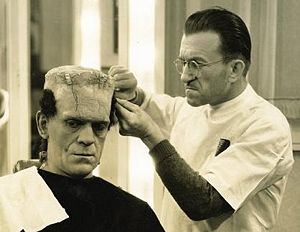When thinking of the masters of makeup effects in the early 20th century, Jack Pierce should be on the top of your short list. Lon Chaney may be known as the Man of 1,000 faces, but its the artistry of Pierce that holds the ultimate top spot for creating some of history’s most iconic creations of all time.
Born May 5, 1889 in the country of Greece, Jack Pierce immigrated to the United States as a teenager. He tried several career paths, including playing baseball as a shortstop in the Pacific Coast League.
After getting several jobs in the world of cinema, Jack settled on the field of makeup. In 1915, he started working on several productions. The Monkey Talks, a 1926 silent picture, Jack created makeup for a talking simian portrayed by actor, Jacques Lernier. Carl Laemmie, the head of Universal Studios loved what Jack did and had him work his magic on the 1928 silent picture, The Man Who Laughs. Actor Conrad Veidt was given a broad stiff grin effect that would later end up being an influence on the look of Batman’s arch nemesis, The Joker. Jack was then hired on a full time basis by Universal Pictures.
Jack’s first talkie would be the 1931 film Dracula, starring Bela Lugosi. He created a special color greasepaint for the Prince of Darkness but was never allowed to apply it himself. Only Lugosi would put the makeup on unassisted. It would be the next film that would forever cement Pierce’s legacy as a master of makeup. That film would be Frankenstein (1931). Originally the monster would be portrayed by Bela Lugosi, but he felt the role was beneath him and the role went to Boris Karloff. The original design of the monster was heavily influenced by the 1920 German film The Golem since both Carl Laemmie, Jr. and original Frankenstein director Robert Foley were both fans of German Expressionism in film. When James Whale took over the reigns as director, the concept for the Monster would change and Pierce created the Monster we all know and love today. It’s unclear how much of the look of the Monster was influenced by James Whale but Jack is considered the sole creator.
Jack would become the head of the makeup department at Universal, and with that, several classic Universal Monsters would be born by his hand. The Mummy (1932), The Bride of Frankenstein (1935), Son of Frankenstein (1939) and The Wolfman (1941) to name just a few.
Jack’s temper and sometimes rough relationships with his actors like Lon Chaney, Jr. would lead to his firing in 1946. It was thought that Jack resisted makeup techniques that the studio felt would expedite the makeup process and make it easier on the actors who had to wear it although there is some controversy around this theory.
After he was given the heave-ho by Universal, Jack would mostly work on low budget westerns and horror movies. But he would occasionally land big productions such as the 1947 film The Secret Life of Walter Mitty and 1948’s Joan of Arc.
His last job, ironically would be from an old associate from his Universal days, Arthur Lubin who would give Pierce a steady gig providing makeup for the 1960’s television show Mr. Ed.
At the age of 79, Jack Pierce would die on July 19, 1968, leaving a legacy for future artists to follow including Tom Savini and Rick Baker.
Below: Jack Pierce works on actor Boris Karloff.

Other Vital Statistics:
Born: May 5, 1889, Greece
Died: July 19, 1968 Forest Lawn Memorial Park, Glendale, California
Trivia:
Jack was known for his signature work in hair, giving many actors a widow’s peak hairline.
Although Jack is remembered for creating some of the most iconic creations ever, his work for the most part was uncredited.
His work in makeup was never nominated for an Academy Award. His only award was the Lifetime Achievement Award from the Hollywood Makeup Artist and Hair Stylist Guild in 2003.
Other Places of Interest:
IMDB
If you want to know more about the history of horror makeup effects, I have a great 11 part series from writer Scott Essman. You can find that here.
Back to
the Features Page
|

